The 2021/22 Women’s Champions League final, which took place in Turin, saw Barcelona Femení and Lyon Féminin meet for the fourth time in their history.
The latter side had won all four meetings.
As a result, overcoming them has proven impossible for Barcelona over the years, with Lyon the only team they have never beaten on a football pitch.
The rivalry that has emerged between the two has become one of Europe’s most well-known, and the latest chapter of it took place at the weekend as they met once again in this year’s final, held at Athletic Club’s San Mamés Stadium.
It was a game that many around Europe had long been looking forward to.
It proved to be well worth the build-up that it had been afforded, with Barcelona finally ending their long wait for a win in a hotly-contested affair and completing a quadruple for the campaign (having already acquired the Liga F, Copa de la Reina and Spanish Super Cup titles) whilst also preventing Lyon from adding a ninth European title to their honours list.
This tactical analysis will break down how the Spanish side managed to edge out their opponents and emerge with the win, highlighting the game plan they set out to implement and the changes they made to their tactics as the match went on.
The analysis will also indicate what Lyon sought to do from the early stages and why it ultimately failed.
Barcelona Femení Vs Lyon Féminin Lineups

Barcelona Femení head coach Jonatan Giráldez made three changes to his starting lineup after last weekend’s win against Real Sociedad Femenino in the Copa final, with goalkeeper Sandra Paños, former Manchester United Women full-back Ona Batlle and forward Clàudia Pina all dropping to the bench.
Cata Coll
started between the posts, while versatile Sweden international Fridolina Rolfö took Batlle’s place at left-back. Ex-Manchester City Womenplayer Keira Walsh came into the midfield to replace Pina.
Centre-back Mapi León, who has spent much of the campaign on the sidelines with a long-term knee injury, was cleared to return to the matchday squad and was named among the replacements.
Giráldez’s Lyon Féminin counterpart Sonia Bompastor opted for continuity after her side sealed the Division 1 Feminine title in last weekend’s play-off final against PSG Féminine, in what is expected to be her final match in charge of the club before she succeeds Emma Hayes at Chelsea Women this summer.
Therefore, Haiti international Melchie Dumornay kept her place at the top of the pitch, operating in the same role as she has done in all three of her previous outings, while Norway striker Ada Hegerberg was on the bench as she continues to recover from her own injury problems.
Barcelona Femení’s tactics
Throughout Giráldez’s three years as Barcelona Femení’s head coach, he has constantly sought tactical adjustments to keep his side ahead of their nearest competitors.
This policy has proven to be hugely successful, as it has allowed them to retain a strong sense of unpredictability and always have different ways of winning matches.
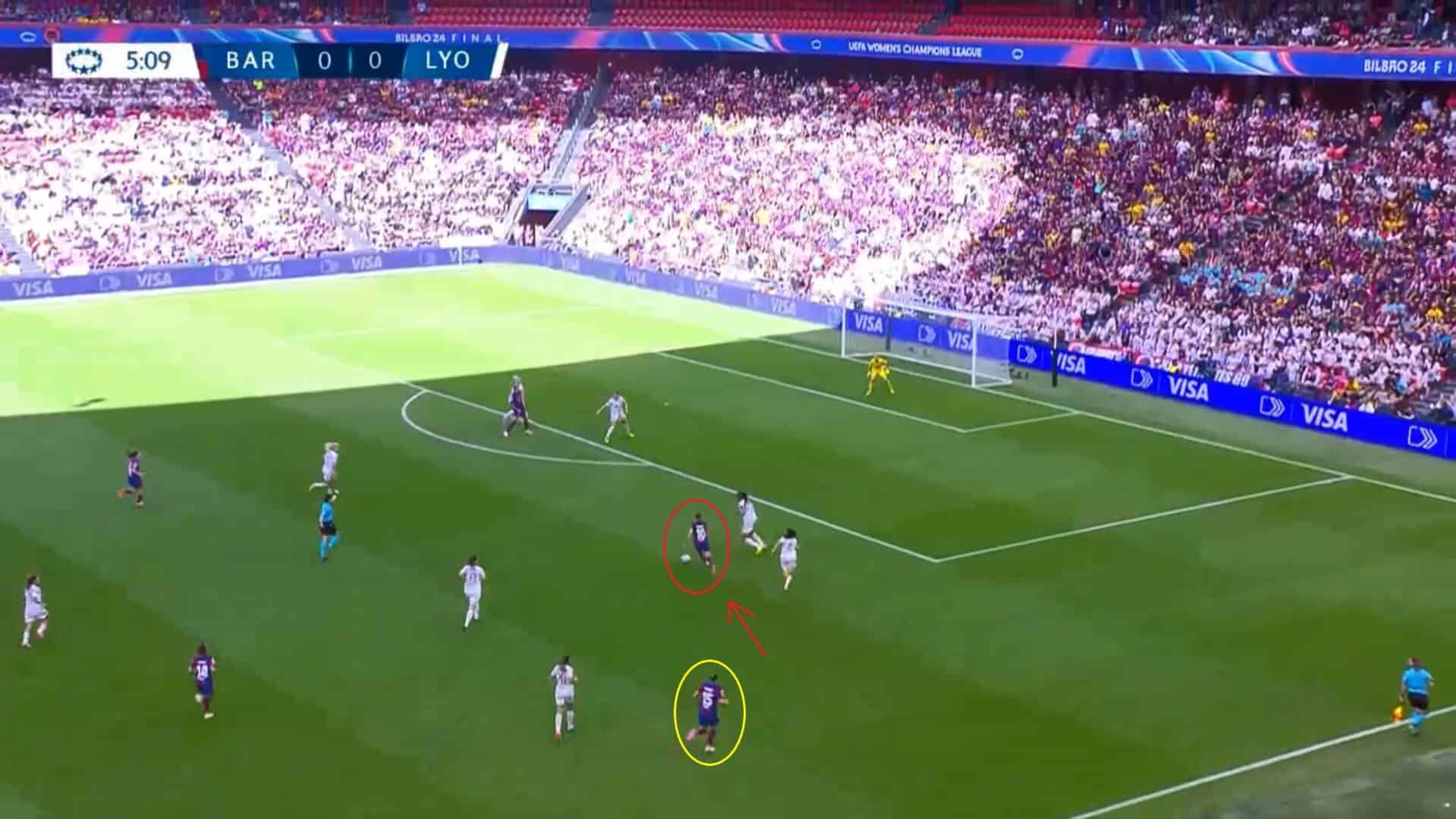
The ability to build attacks in different ways was a key theme of this encounter, too, particularly in the first half.
It was clear from the outset that Lyon Féminin were looking to sit back in a compact defensive shape, so Giráldez’s side would need to be adaptable and find different ways of breaking them down.
One way they looked to create chances was by stretching Lyon out and allowing Caroline Graham Hansen to make runs into central positions. That has formed a key part of their game plan throughout much of the campaign and has always served them well.
However, it only works if every player plays their part, and one person in their ranks who deserves a lot of praise for doing just that is Lucy Bronze.
From the first whistle, the England right-back was constantly seen moving into advanced spaces whenever Barcelona had the ball and looking to stretch the Lyon players out towards her.
This gave Graham Hansen not only the ability to make inside runs but also to have gaps that she could exploit.
On this occasion, the Norway winger was able to get a shot away at goal once she had made her way infield, which ended up missing the target.
Still, the threat was there, and it demonstrated that Barcelona were in the mood and that Lyon would need to be wary about affording their key forward threats too much space as the match went on.
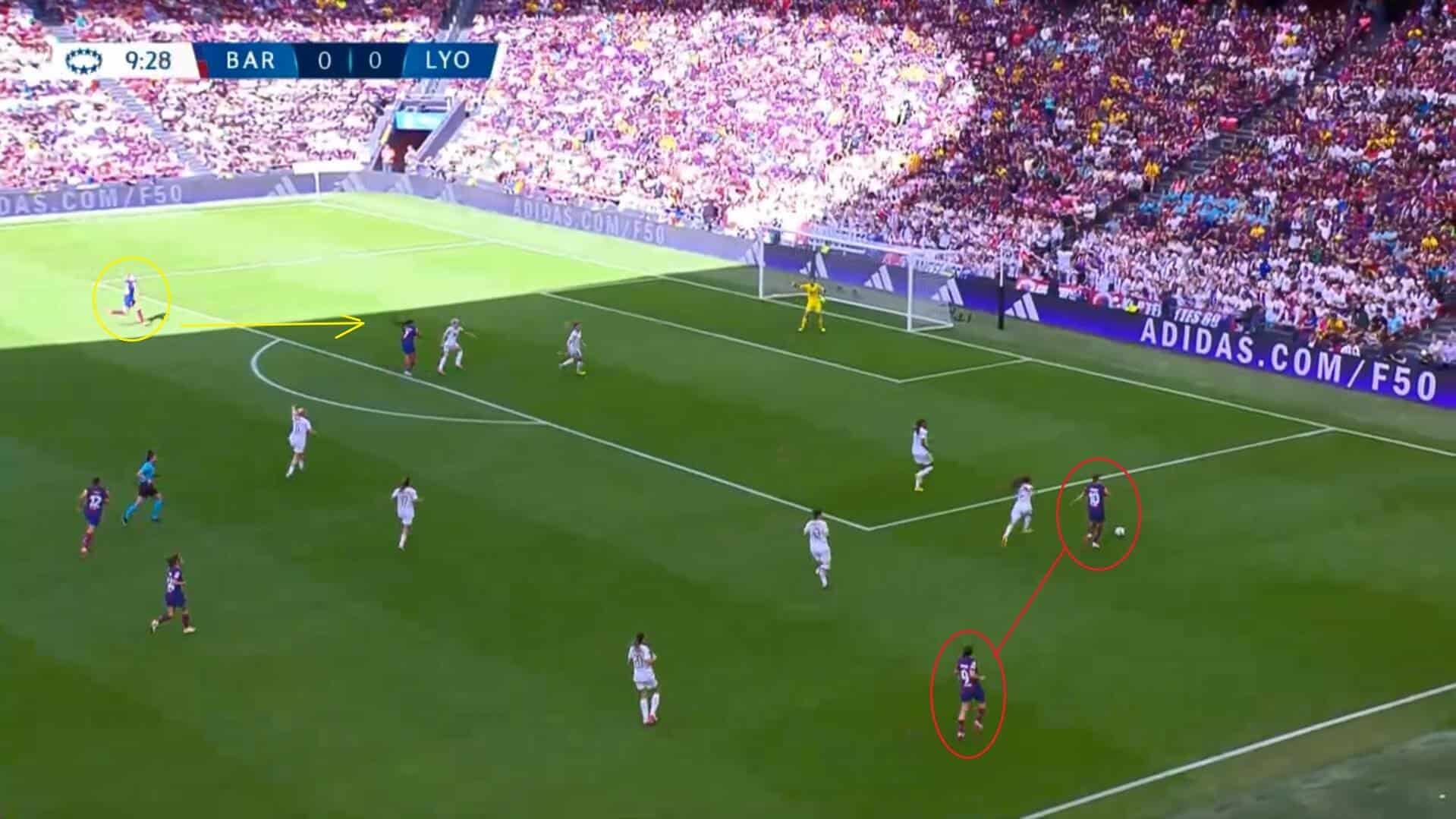
Graham Hansen was not the only player Barcelona was looking to get into central areas, though.
This is where the unpredictability mentioned earlier comes into the equation.
Something that was just as common in the first half was for Barcelona to shift players out towards the right side of the field, forcing Lyon to focus on them and removing their attention from the other side.
As a result, they could give Rolfö time to move up the pitch and offer further support to their attacks.
She is a forward by trade and, therefore, in her element when in front of goal.
In this case, Mariona Caldentey‘s leaving her left-wing role and joining Caroline Graham Hansen on the nearside wing has facilitated this move, and it is clear that this has now attracted the attention of the entire Lyon team.
As a result, when Graham Hansen sends the ball into the space between Chile goalkeeper Christiane Endler and her back four (known as the “corridor of uncertainty”), Rolfö has Bilbao’s freedom to move towards goal in a bid to turn the ball into the back of the net.
Much like Graham Hansen’s effort, Rolfö failed to find the target here, and Barcelona was, therefore, unable to capitalise on the opportunity to take the lead (which became their biggest hindrance before the break).
However, the threat was once again there for all to see, and it highlighted again how Barcelona knew what they wanted to do from the early stages.
Mariona Caldentey Touch map
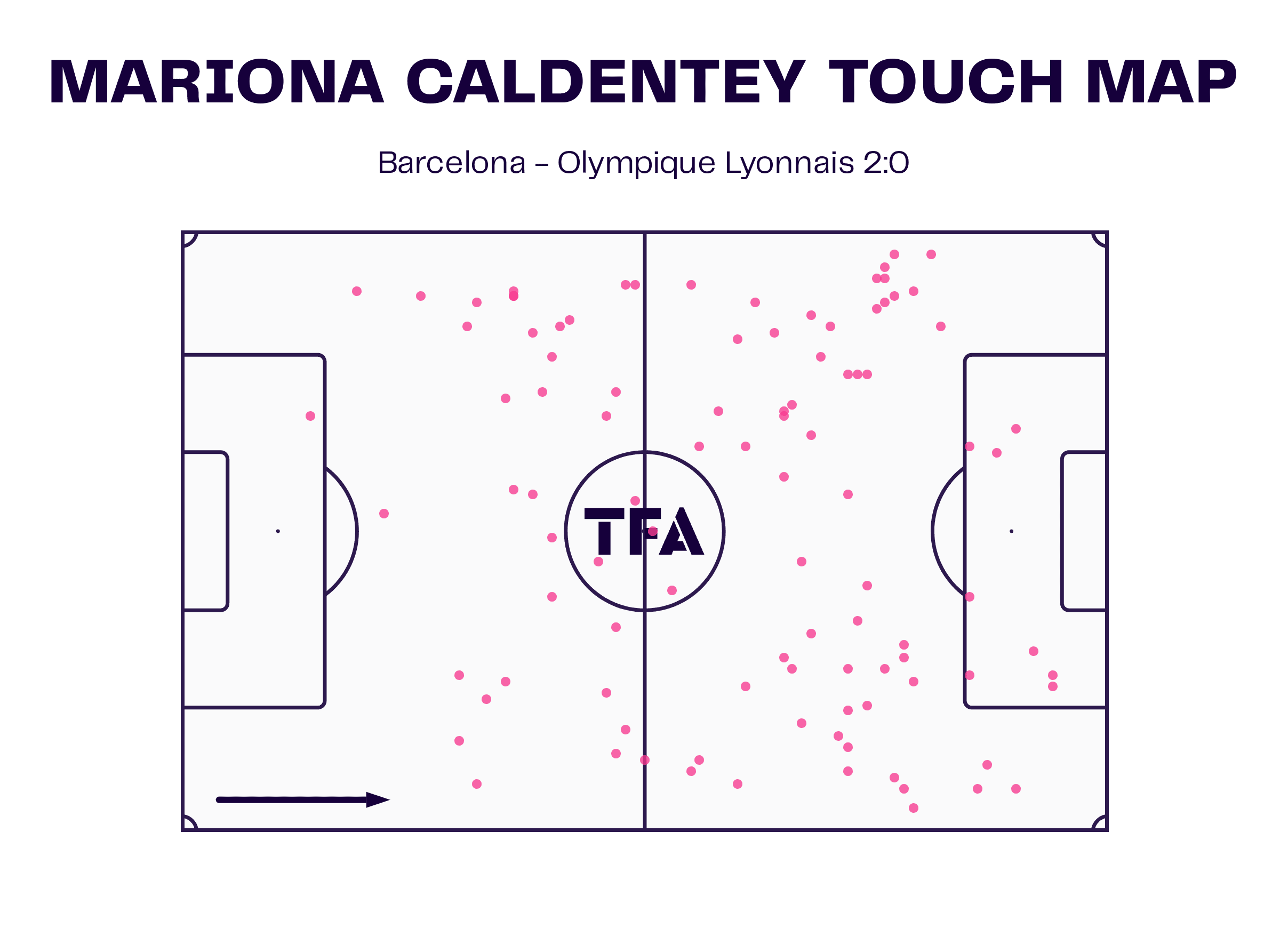
Bronze has already been highlighted for her role in making Barcelona’s attacks possible, but Caldentey also deserves a mention for her contributions.
She has undoubtedly been Barcelona’s most underrated player for so long now.
Her biggest quality is her ability to start in one position but then move around the field and continually connect with those around her, allowing them to get into favourable positions.
As this graphic illustrates, she offered the same threat in this match.
As the match went on, she floated into many different areas of the pitch and played a vital role in Barcelona’s ability to keep testing Lyon’s defensive shape.
It is not hard to see why she has been so sought-after when breaking down her performances not only in this match but throughout the campaign.
Her contract ends this summer, and Arsenal Women are reportedly close to adding her to their ranks. Barcelona would certainly miss her if she were to move on when the transfer window opens.
Barcelona Femení’s changes
Despite the clarity that Barcelona Femení continually displayed in all that they did before the break, there is no getting away from the fact that the half-time score was 0-0, with Giráldez’s side working hard and him visibly pleased with their efforts but with them not having anything to show for them.
As a result, he and they would have known that something perhaps needed to be altered if they were going to convert their dominance into a victory and have a chance of ending their long wait for a win against Lyon Féminin.
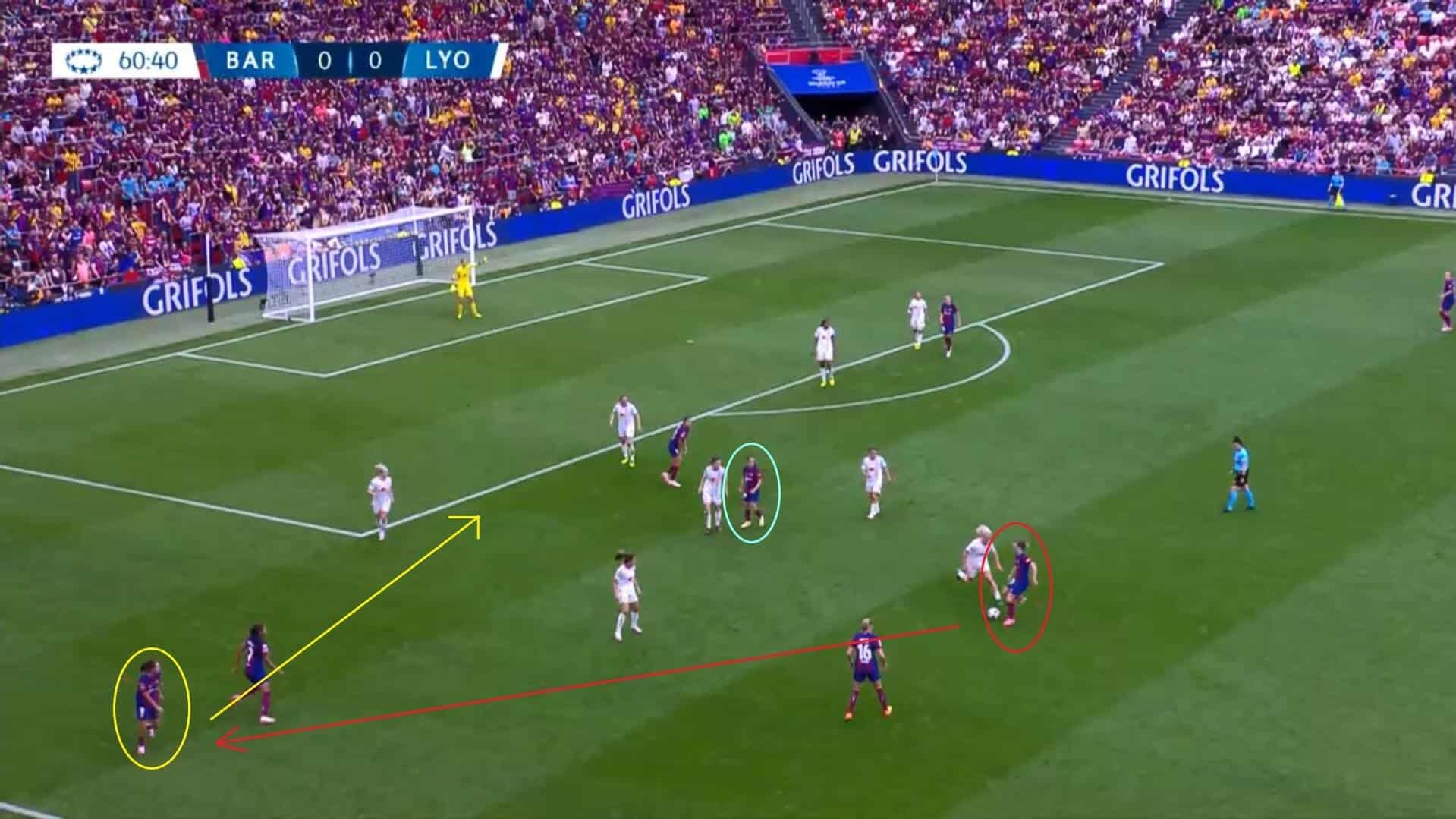
It wasn’t a case of ripping up the game plan and starting again, though.
Instead, a lot of what Barcelona did alter was subtle and barely noticeable.
They played in the same expansive manner and once again kept control of the ball as they sought to break through the Lyon lines.
However, what did change was that Barcelona looked to make more forward runs than they had been doing in the first half, which allowed them to instigate more of the passing triangles that have become so synonymous with their brand of football.
In this case, Walsh has received the ball from Aitana Bonmatí and moved it out towards Caldentey, who then sends it back towards Bonmatí, allowing her to penetrate the gap that Lyon has left available ahead of her.
On that occasion, the chance didn’t come to anything due to Lyon doing enough to thwart Aitana Bonmatí’s progress, but the fact that the opening goal came only a few moments later and from a carbon copy situation shows just how effective this change of approach towards their attacking play proved to be.
It allowed Barcelona to not only play with the same possession-based tactics but also to now have an end product to pair with it.
Aitana Bonmatí Pass Map
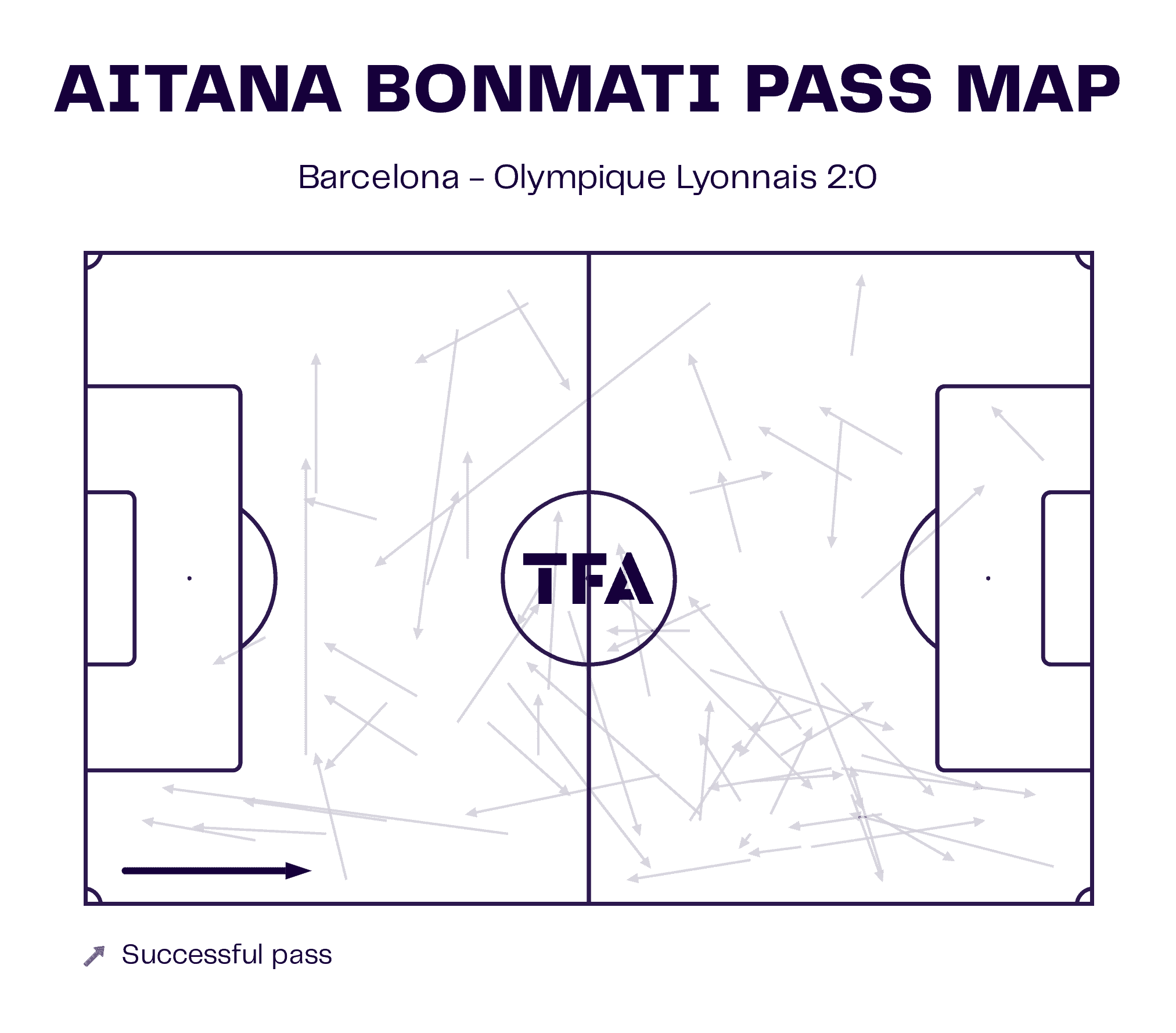
Bonmatí was, in many ways, the epitome of this alteration. She endured a quiet first half because Barcelona didn’t make these types of forward passes, and so the general flow of the game didn’t suit her strengths.
This graphic highlights her minimal impact. She made the same high number of passes as she always does but never really gained the same amount of territory with each one, and that is the key point to take from this.
However, in the second half, Barcelona’s increased desire to get numbers up the field and to take up more positive positions played much more into her hands and allowed her to give a truer reflection of her qualities, which ultimately led to Barcelona taking a deserved lead.
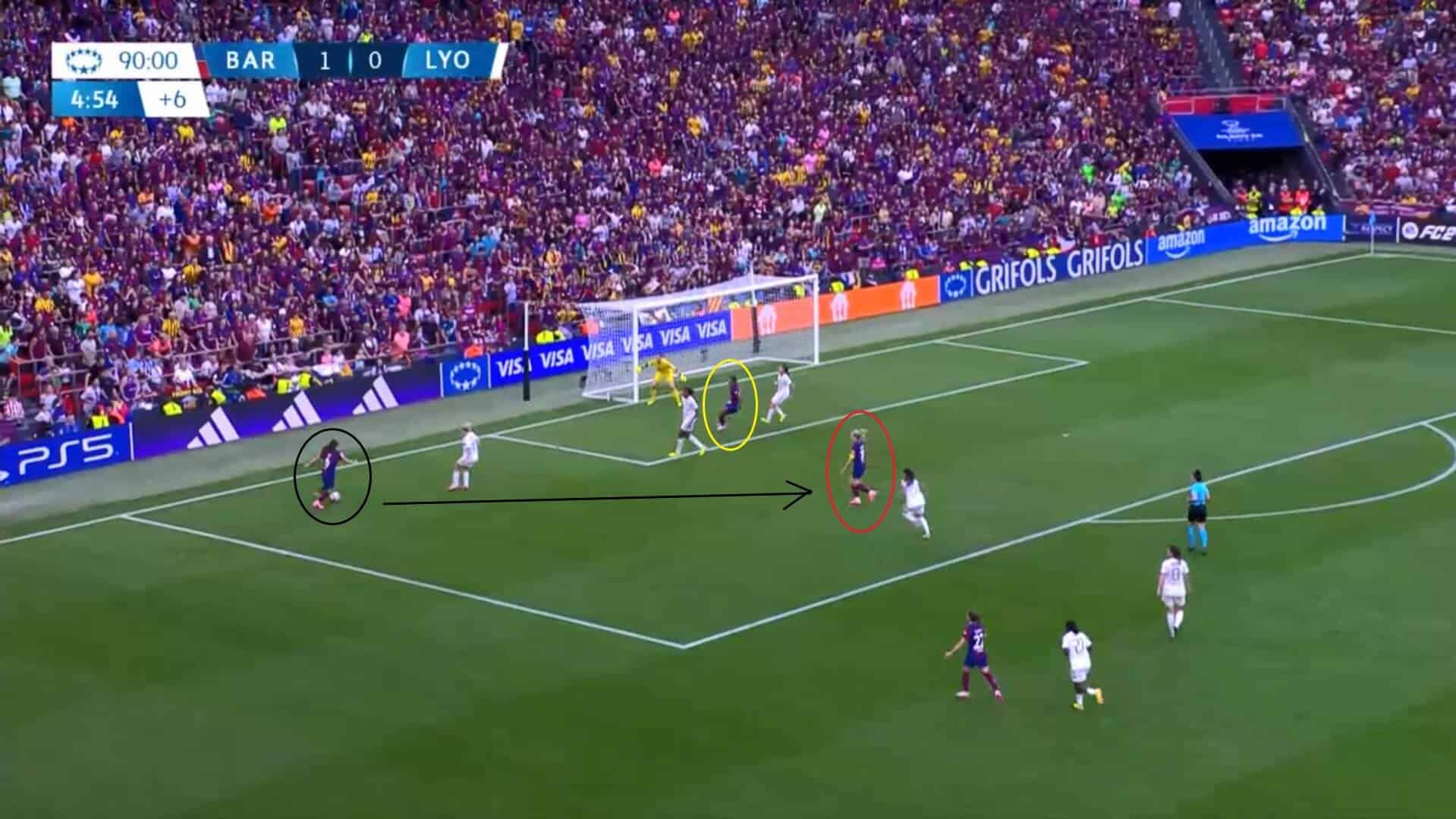
Getting the first goal seemed to give the Spanish side even greater confidence that this approach was the right one to take.
They began afterwards to play on the front foot even more and to keep teasing the Lyon defensive line apart.
This was further aided by the introduction of Esmee Brugts for Salma Paralluelo at the top of the field.
Her pace allowed her to create more gaps and use Lyon’s weariness against them.
The second goal resulted from that vertical stretching, with Alexia Putellas joining the fray to sit in those spaces and give Barcelona even more layers to their attacking play.
With her here in just such a position, fellow substitute Pina has been able to pull the ball back for her to send into the top of Endler’s net.
It might not appear to have been a difficult goal to score, given the amount of space that Barcelona had been afforded by Lyon (largely due to Bompastor’s side switching to wing-backs by this point).
Still, it was made to look that way by the precision and understanding that each player involved in creating it demonstrated.
It is that that ultimately saw them deservedly secure a third Champions League title and a second in two years.
Lyon Féminin’s game plan
In contrast to Barcelona Femení’s well-executed game plan, Lyon Féminin were not at their best and were under pressure from the first whistle.
However, this is not to say that they didn’t come into the match with a clear idea of how they wanted to play, with it evident that they, too, had worked on a game plan that they believed would secure them the win.
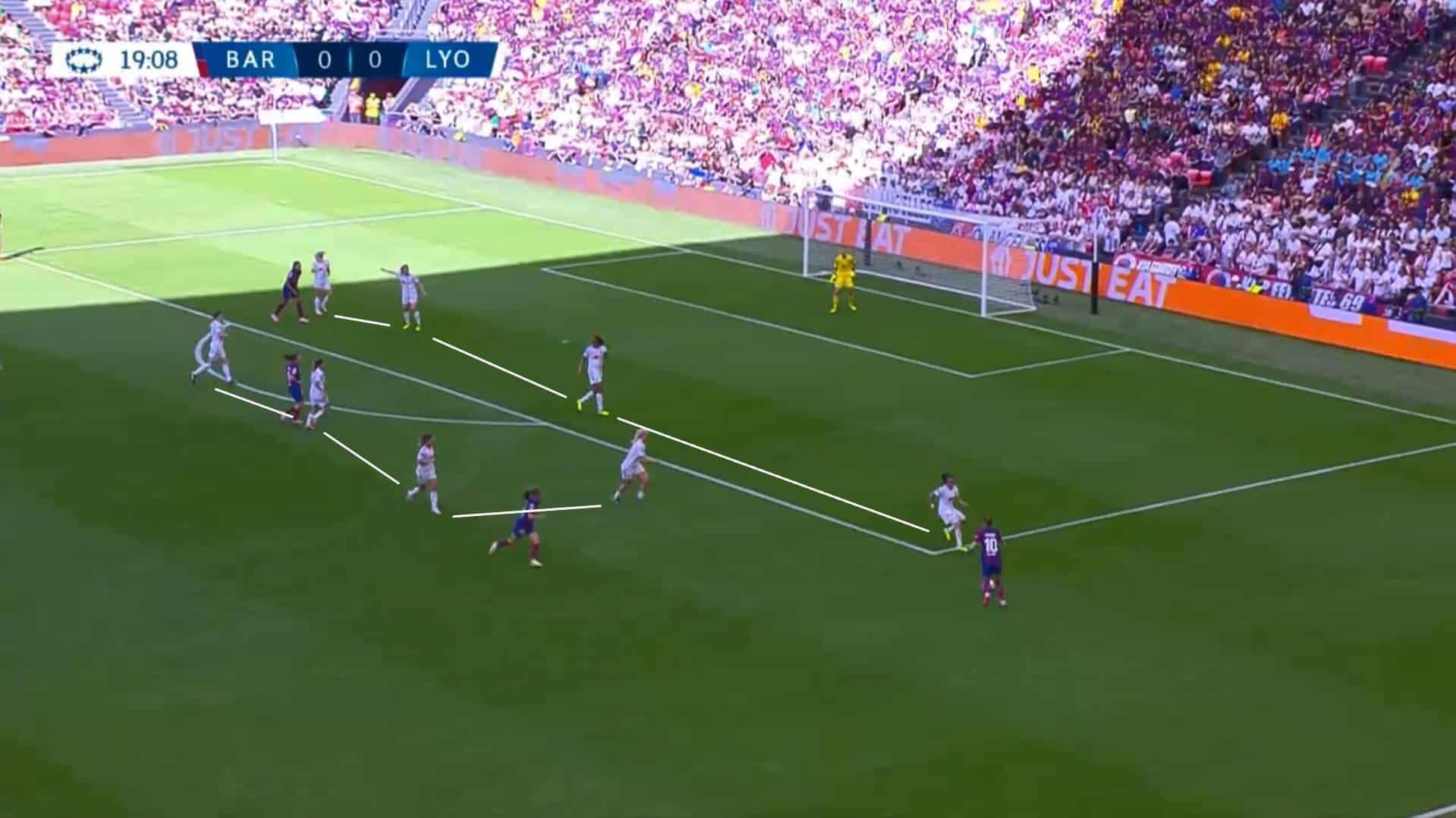
The first part of that has already been set out in the analysis, with Bompastor’s side looking to take up a compact and organised defensive shape as soon as they lost the ball and to ensure that there was as much distance between it and their goal as possible.
As is clear here, their ability to make this work came down to every player buying into what they were looking to achieve from it, and the fact that there is so much communication indicates how that unity was present from the outset.
However, their focus on the central areas was perhaps their first mistake.
It meant that they weren’t paying as much attention to Graham Hansen and weren’t making as much of an attempt to close her down as they perhaps should have.
In this case, Selma Bacha has moved out towards her but has done so on her own, and so the Barcelona player is able to move the ball around her in either direction and create a shot on goal.
Given that Chelsea achieved such success during the first leg of their semi-final against Barcelona by isolating and therefore neutralising Graham Hansen’s threat, Lyon might have been better served by adopting the same methods and thereby preventing Barcelona from creating the chances that they did.
However, they seemed to feel that they could keep their opponents at bay by remaining narrow in this manner, and the fact that they did go into the break having not conceded does, in some ways, justify that thinking.
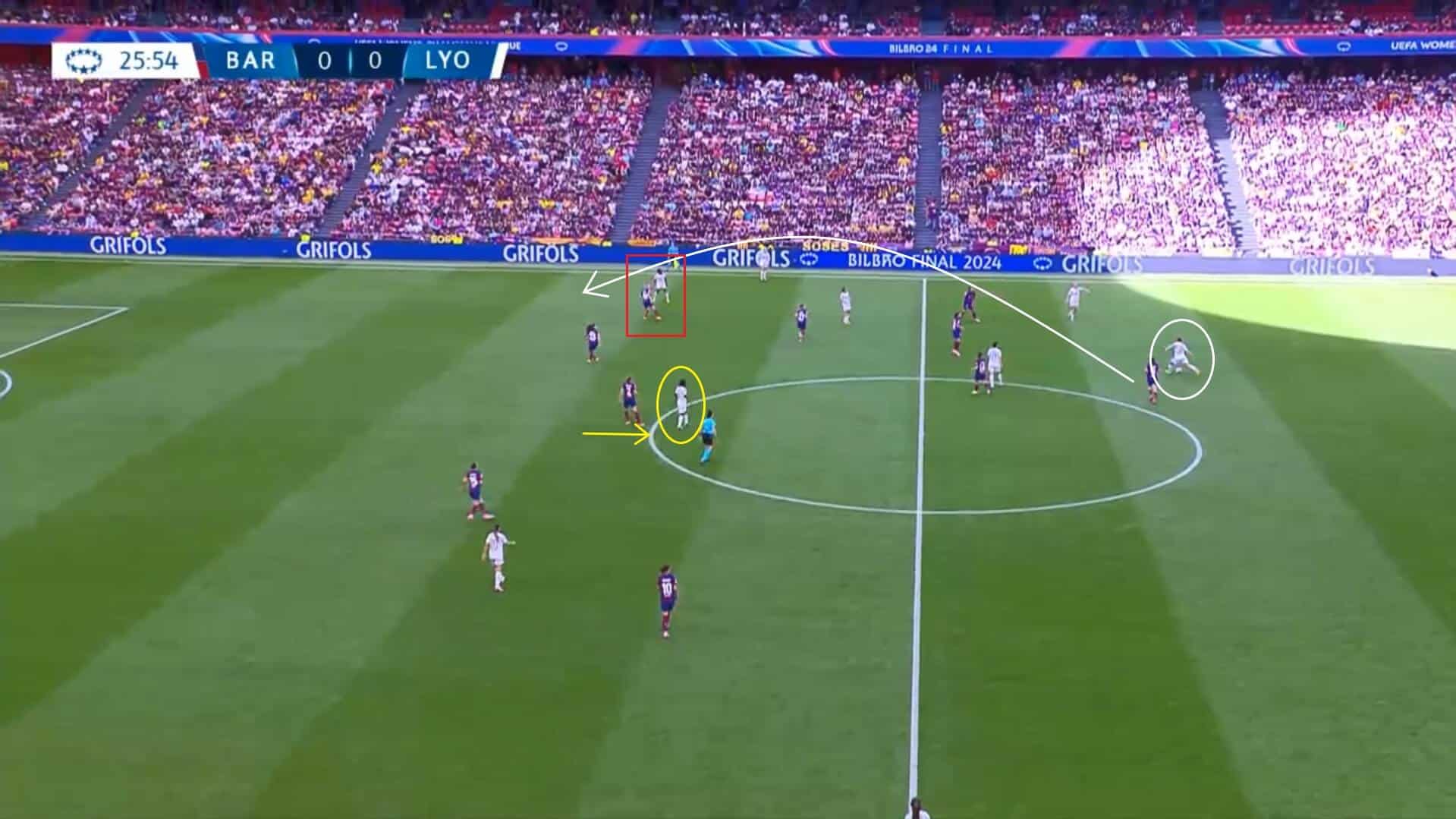
The next phase of their game plan was where Lyon really struggled.
Their tactics were to move the ball up the field as quickly as possible and give their forward line opportunities to break behind Barcelona’s high back line.
However, what let them down was that Dumornay was starting at the top of the field.
Her reputation for running at defenders with pace should have seen her making runs between the defenders, but she instead tended to drop back, as she is doing here, rendering herself largely ineffective when Lyon tried to counterattack with long direct passes.
As a result, Lyon could only send the ball towards Kadidiatou Diani and Delphine Cascarino, who were positioned on either side of the pitch.
Due to the player’s body angle, whenever the ball was moved up the field, it was immediately obvious which of them was being targeted.
In this case, Canada centre-back Vanessa Gilles has turned towards the far side of the pitch and created separation in a way that makes her intention to find Diani apparent.
This allows Rolfö to react early and ensure that the long pass doesn’t lead to anything.
This was not the only time that Lyon lacked quality when moving the ball from one end to the other, and it was this that saw them really end the first half on the back foot.
Their dressing room would have been a lot more anxious at the break, and it was clear that something would need to be changed if they were to turn the flow of the match in their favour.
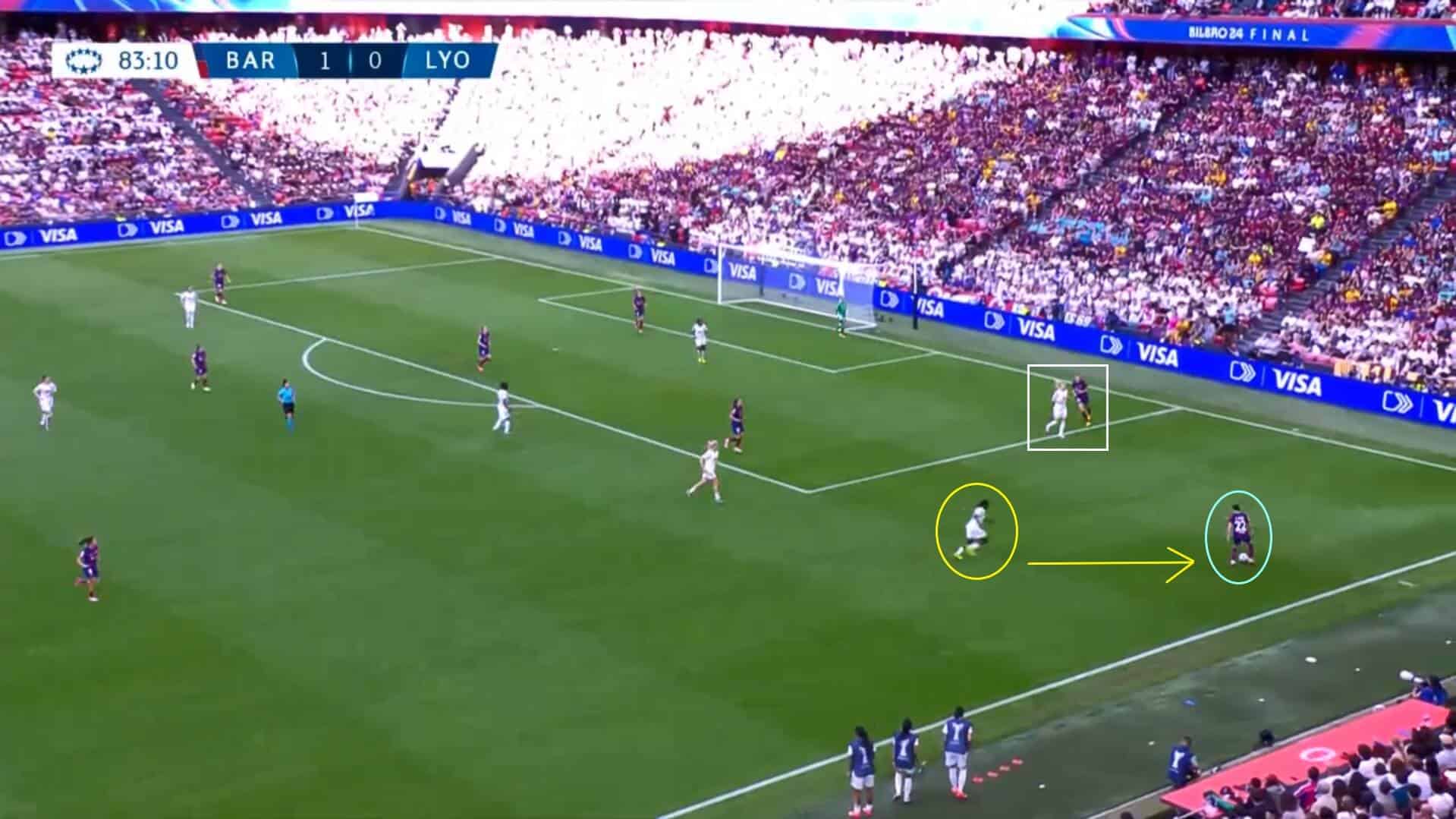
However, those changes didn’t immediately come, and Lyon instead seemed to put faith in what had not been working in the first half. They did nothing differently until after Barcelona had taken the lead.
By that stage, Bompastor’s team was chasing the match, so their decision to bring on Vicki Bècho and Hegerberg and to change to wing-backs was only ever a reaction and not a case of them being proactive.
That is not to say that it didn’t affect the game. Lyon certainly changed their mentality to be more front-footed with those players on the field as they tried to press intently and force mistakes from their opponents, just as Bècho is doing here against Batlle.
However, there is always a downside to this formation, and Lyon ultimately succumbed to it.
Their defensive line was too open, presenting Putellas with the chance to get between their players and seal the match’s outcome.
Therefore, whilst there were some positive signs from this change, Lyon ultimately had no answer to Barcelona as the match went on, and that was what saw them suffer defeat for the first time in their history.
Conclusion
In conclusion, this tactical analysis has examined in detail the 2023/24 Women’s Champions League final, contested by Barcelona Femení and Lyon Féminin. It has broken down the game plans that both teams sought to operate with, as well as the positives and negatives that each experienced as the match went on.
In the end, Barcelona came out on the right side of the scoreboard.
They were the better side overall in Bilbao and put on a performance worthy of the historical quadruple that they have now succeeded in attaining.
As the analysis has highlighted, they did have to show patience and adaptability, but they demonstrated that they have that in abundance in this match.
They are a team that will always find a way to win.
Lyon’s loss in this match means they lose their status as the only team yet to lose to Barcelona.
However, what they still hold over everyone else is their record of eight European titles, which is still a long way ahead of every other team on the continent, with Eintracht Frankfurt Frauen’s four titles being the next highest number won.
Therefore, Barcelona might have won this match, but there is still a long way to go before they can truly remove the French side from their throne.
This certainly makes for an interesting period of time to come as the Spanish giants look to chase that record and further cement their profile as Europe’s strongest side.
While this is Lyon’s final match of the season, Barcelona still has two Liga F matches to go before their season concludes.
Following the international break, they will first host Real Betis Féminas before ending their campaign away to Valencia Femenino.





Comments